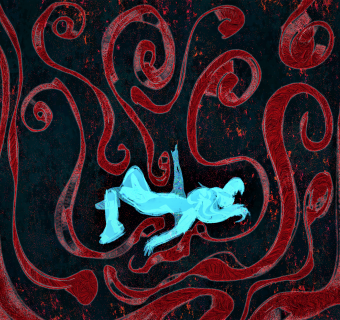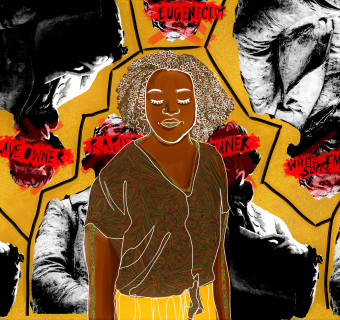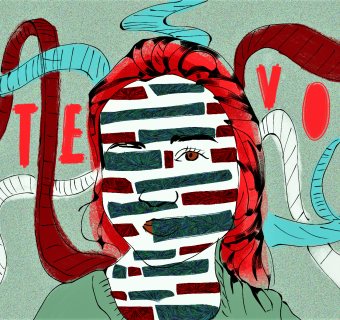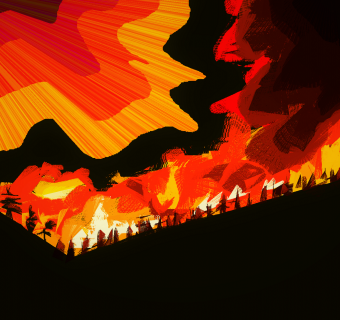It is not often that one gets the opportunity to explore the inquisitive mind of one of their favorite artists. Luckily for me, one of mine happens to be a professor of the University’s McIntire Department of Art. Lydia Moyer is an artist that has been screened nationally and internationally and has worked in all mediums of studio art from sculpture to printmaking. She gave me the pleasure of an interview to further explore her artistic perspectives, desires, and projects, as well as thoughtful, honest advice for our generation.
Moyer began her education in Studio Art by receiving her BFA at NYSCC at Alfred University, before doing graduate studies at Concordia University and receiving her MFA at the University of North Caroline at Chapel Hill. Since then, she has participated in exhibitions and curatorial projects at an impressive amount of galleries, a number that grows every year, all the while maintaining a striking presence at the University of Virginia. In terms of inspiration, Moyer carries a realistic take. “The word inspiration always feels a bit uncomfortable to me,” she says. Instead, she attempts to consciously and internally seek what interests and motivates her. “Making things can be a great way to gain insight, an excuse to look really closely at ideas or stories or anything, really. It’s a means of dissecting. When I’m troubled by something but also really curious about it, I find my artwork naturally follows.” It is this very perspective that has aided her success in studying and presenting in a multitude of cities and states, thus raising the question: Why Charlottesville? “The lure of a job that would allow me the time and the resources to keep making things, and the mountains,” she says. Her favorite things about UVa are the collection of libraries and being able to connect with her students. “[The best part of] teaching is watching them grow, as I often work with the same students for 2 - 3 years. They are some of my favorite people and it gets hard to let them go,” Moyer says further. It’s no wonder she has a 4.0 on Rate My Professor in terms of quality, helpfulness, and clarity. Though she works with all forms of studio art, Moyer’s primary medium is video. Discussing her current works (though working on many projects at once), her immediate focus has been on a documentary series called Paradise. A set of various video shorts, it’s a project 7 years in the making. Additionally, she has been creating many pieces through a collaborative project Tory Wright, called Hateful (my personal favorite, and hers too at the moment!), found here. “Working with someone else has been liberating. We take a lot of risks because we can do it together.” As someone not so artistically inclined, I always wonder if there’s a magical “a-ha!” moment when one discovers that they want to become an artist. “In some ways, I’m still not sure,” Lydia explains. “Studio art has allowed me to engage with a lot of different things in a lot of different ways… my practice can stretch to encompass really varied interests. I’ve stuck with it but it’s almost been more of a process of coming to terms with a career as an artist, rather than actually pursuing it.” Though Moyer has seemingly grown into an artist rather than seeking it out, her views on her own motivation are refreshingly modest yet undoubtedly driven. “My work often springs from my idealism and an attempt to reconcile that idealism with the world we live in. I’d be trying to reconcile those thing even if I wasn’t making art.” Further, she says, “In the most unromantic way, I think art is often about compulsion. The arts are too uncertain if one has to consciously seek motivation. If someone isn’t compelled to make things, I think they’d be smart not to abandon their interest in art but to find another way to make a living in order to be comfortable. That said, sometimes it takes a while to recognize these things, whether one is compelled or not. The influences and community around you can make a huge difference” On how her art reflects what is going on in the world, she provides a wise mantra: “I think it’s my job to distill personal experience or interest into something that other people can understand or from which they can get something, whether it be a feeling, an insight, a question, anything.” In this way, Moyer attempts to use her art to reflect the world through a very personal lens. Delving into further discussion on her attempts to make an audience feel something towards her work, we discussed her desires as an artist. “There’s an article by a video artist and activist named Greg Bordowitz that I have my students read every year in which he outlines the operative assumptions of his practice,” she says. “One of them is, ‘What are the images you wish there were more of in the world? Make them.’” It is this advice that gives insight into some of her most immediate drives as both an artist and a teacher. “I particularly want to do this for young, smart women – I make my work for them; women as makers and thinkers, rather than as objects. Sometimes it’s explicit, as with my Hateful collection. Sometimes it is more implicit, as with Paradise, where the female voiceover directs us, expects us to listen to her thoughts, her take on things, simply all the while being clearly female.”
Because one of Moyer’s primary objectives is to empower women, I asked about her mindset back when she was 20 years old. “I remember, mostly, and it has changed a lot in some ways and in others it is maddeningly consistent.” In ways that it has changed, she explains, “I am a lot less idealistic, more flexible, yet I am still idealistic and inflexible.” When asking for further explanation, she adds, “I worked really hard in school and was a very serious student; I think that’s part of how I got where I am now.” Would she have done anything differently? “Sometimes I wish I had not been so intent on my work. I wish I had cut myself a bit more slack and just enjoyed a few more sunny days. Patterns form in the brain and it’s difficult to reroute them.” For those readers who are aspiring artists themselves, I asked Moyer how does one “make it” in the art world, and what even defines “making it?” In response, she says, “I think one ‘makes it’ in the art world like one ‘makes it’ in any profession: through hard work, luck, and perseverance. What it means to make it for me mostly has to do with finding a way to make one’s practice sustainable.” Furthermore, she seems to offer her own definition of art and says that she believes, “Creativity exists in all endeavors. One can be a creative engineer, teacher, barista… all of these require problem solving within the bounds of the discipline.” As far as advice for young artists, Moyer stresses them to utilize this “creativity in all endeavors” concept, not just those officially defined as “art.” “I think there are artists everywhere, they just don’t always call themselves that,” she adds thoughtfully. The Internet as means of a canvas display is so relevant to society, especially for our generation, which has grown up with technological revolutions being the norm. Displaying much of her art on social media outlets such as Tumblr and Vimeo has made her work much more accessible and easier to distribute to a larger and different audience for artists like herself. Of this, she says, “Artists need audiences. Work really isn’t complete until someone has seen it and the Internet can cut out the middle men of exhibitions like galleries and museums for an artist whose work translates into an online format.” For her, and all artists alike that use social media as a form of screening work, it’s been exceptional in helping “artists exhibit their work in the public space without needing to pass the gate-keepers of the art world.” Possibilities are endless. She also muses, “Of course, this means there’s some awful work on the Internet, but also that there’s some stuff that is worthy of being seen that one might never see otherwise and people can work from very remote locations. I find that pretty exciting.” What’s next for Moyer? “I’m hoping to finish up the Paradise series and begin showing all the shorts together as a solo program in venues around the U.S. I’m looking forward to wrapping that up and looking toward new projects.” Concluding our interview, Moyer gave a final word of advice to share with the young women at UVa: “Take advantage of your time here. You have the attention of people who have devoted their lives to what they teach and a vibrant community of peers in your fellow students. Both are invaluable if you engage with them wholeheartedly.”
By Kiana Williams.






